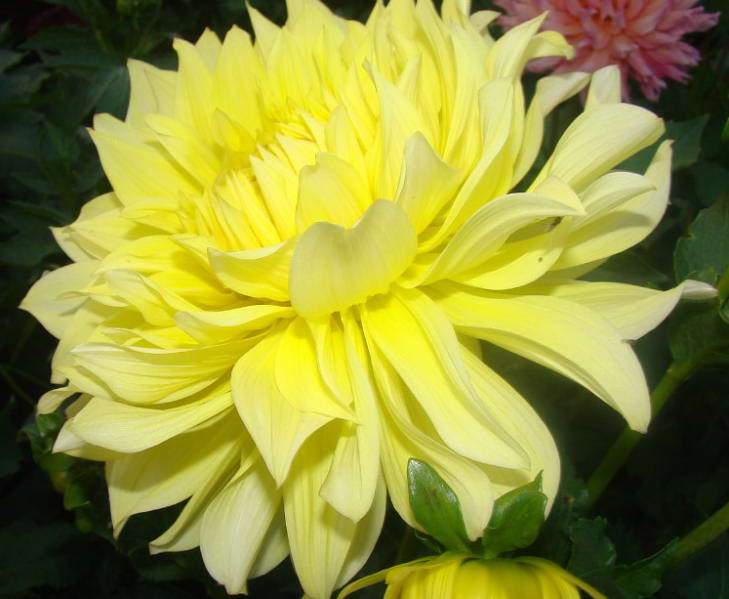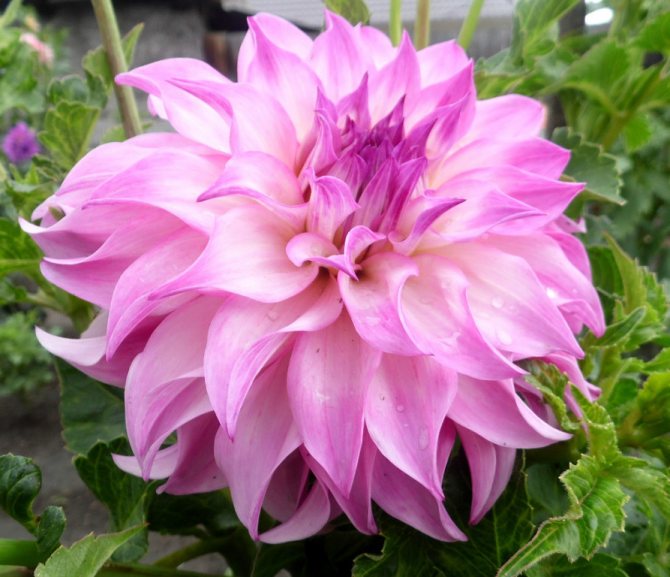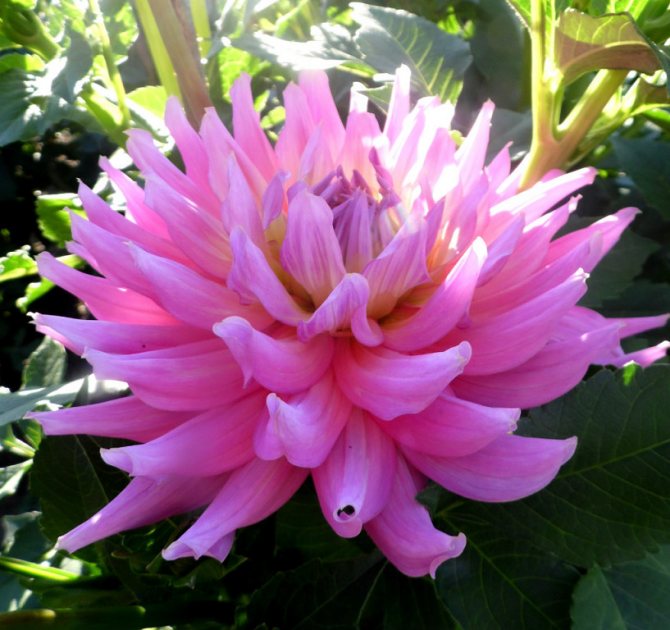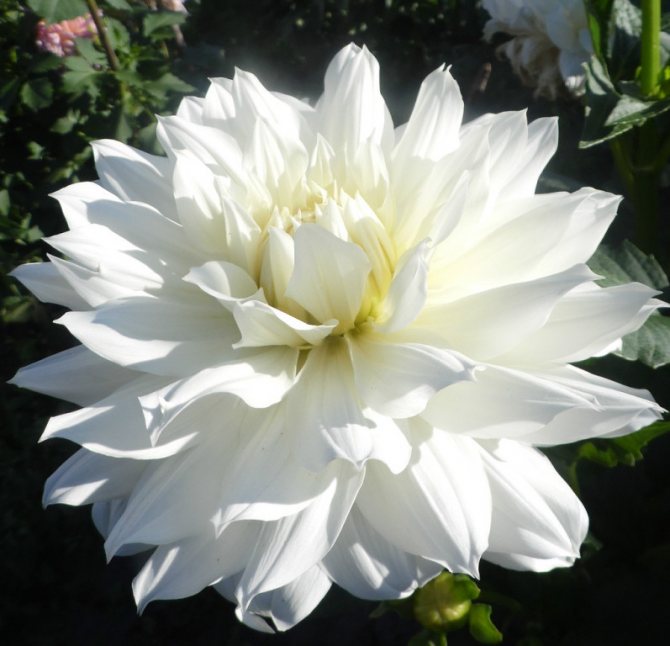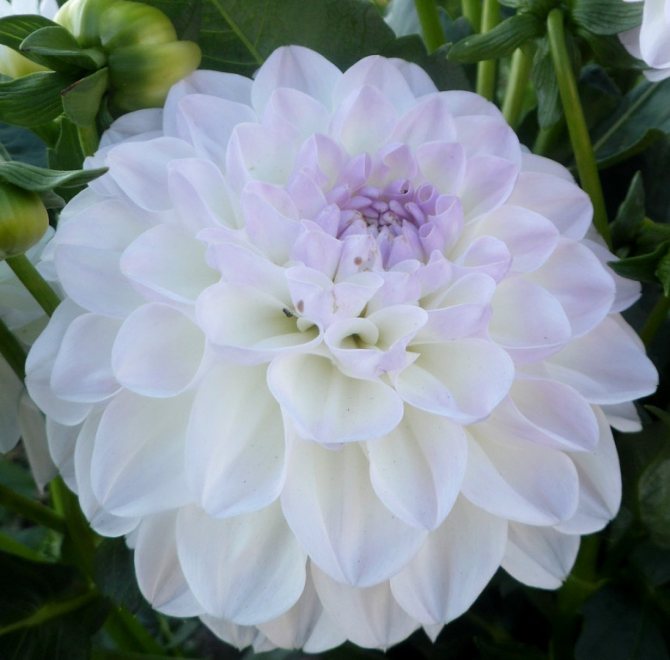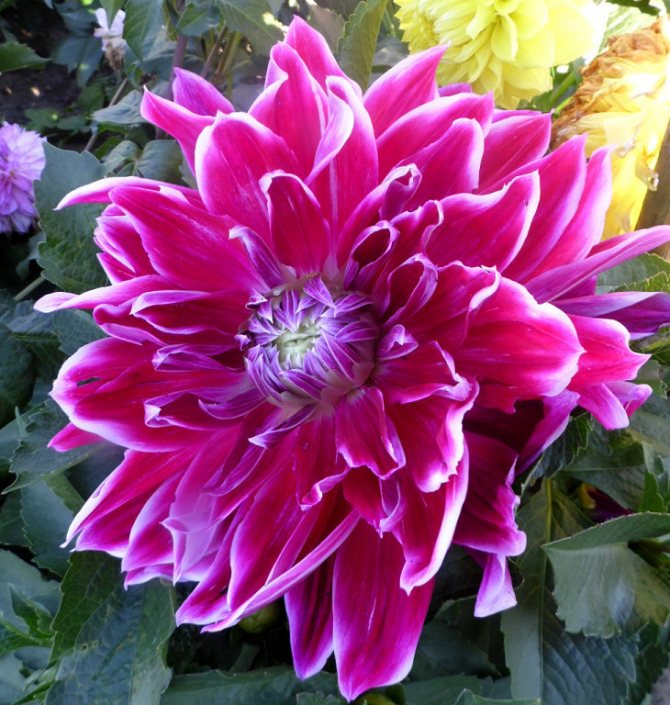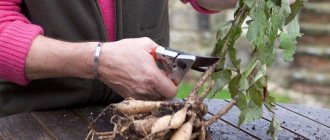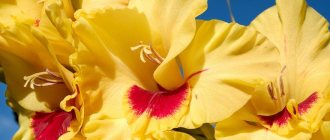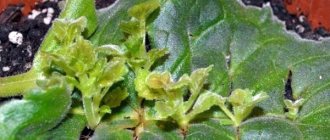
Beautiful, large flowers of various shades that bloom in the second half of summer, when most of the others have long thrown off their "holiday dresses", these are dahlias. Everyone has seen and knows them, but not everyone is familiar with the growing process. Planting dahlias with tubers in spring is a whole process, the rules of which must be followed in order to get abundant flowering in summer and autumn. Let's figure out how to properly cook tubers, how to germinate them so that everything works out as it should.
Planting perennial dahlias
The optimal time for planting dahlias is the second decade of May. Before this time, it is necessary to carry out preparatory procedures. It is very important to dig up the area and mix the soil with compost.
When planting perennial dahlias, you need to consider their preferences. These plants love warmth, so well-lit areas are allocated for them. Dahlias grow well in fertile, loose soil with a neutral reaction. In addition, the soil must be moist. Strong winds can break the tubular stems of dahlias, so areas where wind or drafts are constantly "walking" are not suitable for these flowers.
Stagnation of moisture in the soil should be avoided.
The holes for the dahlias should be three times larger than the lump of roots (40x 40x 40), so that the roots of the dahlia sink into them completely and there is still 5-7 cm left.At the bottom of the hole, lay a layer of rotted compost or manure, then sprinkle the manure with earth so as not to burn dahlia roots, lay the sprouted tuber and dig in so that a few centimeters of the stem are underground.
If you have chosen a variety of tall dahlias, install and secure immediately a support for the future stem. After planting, water the seedlings abundantly with cold water, and mulch the soil around them with a five-centimeter layer of fine tree bark or sawdust, having previously mixed them with peat or compost. Some growers also practice planting with grown dahlias.


After planting, the land is watered and mulched. As you know, return frosts are possible in spring, so dahlias from them can be covered with large plastic bottles with a cut off bottom or other suitable material. If young shoots of dahlias have been damaged by spring frosts, then the plants should not be dug up.
The dormant buds will wake up and give life to the plant.
For this, tubers are pre-planted in greenhouses in April. Before planting in open ground, such plants must be hardened. For this, the greenhouse first begins to open for several hours a day, and then this time is gradually increased.
Dahlias, features and subtleties of planting
In the wild, dahlias grow in Mexico, flower tubers came to Europe a couple of centuries ago. It is difficult to attribute them to cold-resistant plants, since even a small minus on the soil can destroy an adult plant. It is especially important to decide correctly when to plant dahlias in open ground in Siberia and the Urals. There, even in June, there are ground frosts.
Optimal conditions for growth
Flowers do not like intense heat. It is easier to grow dahlias from tubers with an average daily air temperature range of 15-25 ° C.Temperature fluctuations outside this range can adversely affect bud formation and flowering time.
Choosing a place
If you want your dahlias to bloom profusely and for a long time, allocate them a bright area of the garden. Most often, when planting dahlias in the open ground: near trees, fences, structures - the result is sad. The plant may refuse to bloom, it takes at least 6 hours to be in the sun to form buds.
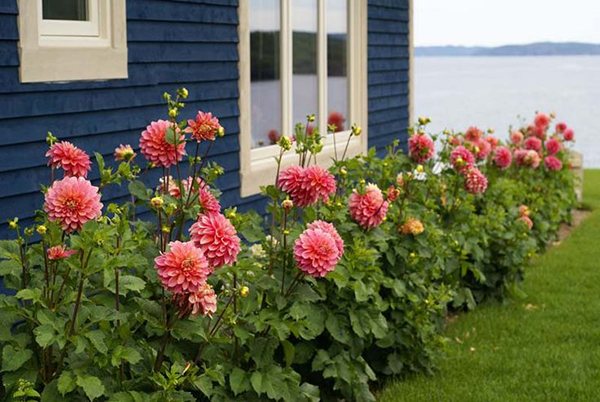

You can lose seed (tubers) when planting dahlias in open ground in a rain-flooded garden area. The plant does not like stagnant moisture, reacts poorly if groundwater is close. Excessive dampness is the main cause of root decay. Therefore, the health of the flower and its decorative effect will depend on how you plant the dahlias, in which part of the garden you plan the flower bed.
There are other subtleties that need to be considered when planting and caring for dahlias outdoors. The flower does not like drafts and strong gusts of wind. Young shoots are especially sensitive to cold draft.
In June, when the temperature drops at night, which is not uncommon in our temperate latitudes, the leaves may die from the cold wind. The stems are fragile, so strong gusts of the north, north-west wind can break them. It is necessary to draw conclusions:
- choose a windy place for a flower bed;
- use supports (stakes).
Advice! In the south, the root zone of the bush must be filled with a roller in order to pour a sufficient amount of water into the hole.
In the southern regions, the wind is no less dangerous to flowers than in the Urals or Siberia. Sultry currents of air burn the delicate leaves, dry out the soil around the bush. Both in Siberia and in the Krasnodar Territory, place the flower bed away from drafts.
Preparing the soil
In the fall, it's time to think about the soil for planting, it is better to prepare it not when it is time to plant dahlias, but in the fall. We note three important soil characteristics that are most favorable for planting dahlias in the ground:
- moisture capacity;
- structure (looseness);
- water and air permeability.
Do a soil analysis when you decide to plant dahlias in your garden, not necessarily a laboratory one. You can yourself assess the structure of the soil, the thickness and amount of humus, if it is necessary to improve its structure. In this case, go the standard way, use organic matter:
- manure;
- humus;
- compost;
- chopped straw;
- peat.
All organic substances that can quickly decompose in the soil, improve its structure, can be introduced into it before planting dahlias.
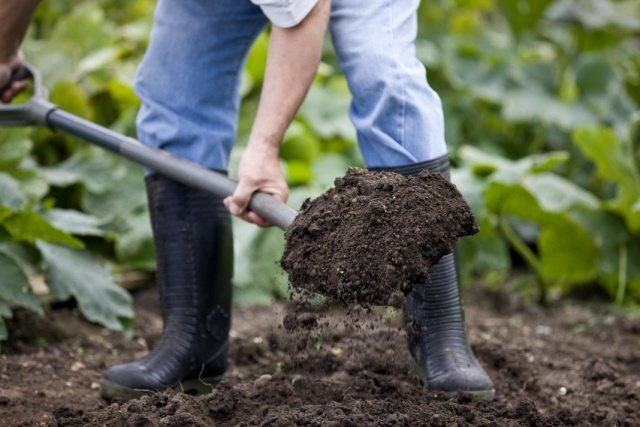

Advice! Apply coarse sand to the soil if your soil is clay-rich.
Many materials, even unusual at first glance, improve the permeability of the soil. When planting, it is necessary to loosen the soil to facilitate the care of dahlias. This can be done with gravel, peat, ash obtained from combustion. If the soil in the garden is light, contains a lot of sand, it is made heavier by adding moisture-trapping components: vermiculite, clay, peat.
When developing virgin lands, flower growers, when they begin to plant dahlias with tubers in meadow or forest soil, note their poor development and weak flowering. The reason may be the increased acidity of the soil.
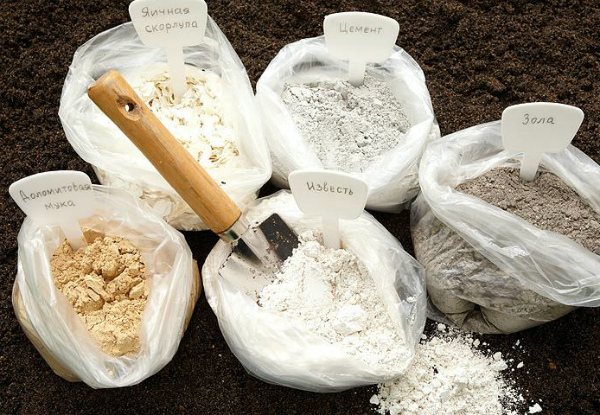

A pH of 4 to 5 is typical for podzolic and clayey soils and is bad for growth. Dahlias do not grow well on alkaline soils, growing and caring for them is difficult. They prefer neutral soils. Alkaline soil, before planting dahlias in it, is acidified - peat is added, slaked lime, chalk or dolomite flour are added to acidic (pH 4-5). Lime consumption per 1 m2 from 300 g to 1 kg.
Advice! Do not apply lime and organic matter (manure, humus) at the same time.
Organic matter will decompose slowly, as lime slows down the growth of beneficial bacteria that feed on organic matter. Add organic matter in the fall, lime in the spring.
When planting dahlias with tubers, experienced flower growers do not advise using mineral fertilizers containing nitrogen (urea, saltpeter) and potassium (potassium chloride, potassium salt). They are quickly washed out of the soil. It is better to add ash to the hole, before planting dahlias, it is a natural supplier of potassium.
Caring for perennial dahlias
The care of perennial dahlias includes the obligatory mulching of the area with flowers. This not only protects the plant from pests, but also protects the soil from drying out, and allows you to abandon loosening and weeding of the soil. Dahlias prefer abundant watering. If there is no precipitation, they are watered 2 times a week. Moisture should not stagnate in the roots of the plant.
Otherwise, the dahlia tubers will rot. To retain moisture on a sultry day, it is necessary to huddle the soil after watering. Before the next watering, the soil is raked from the stems, the plant is watered and huddled again. During intensive growth, dahlias are fed twice a month.
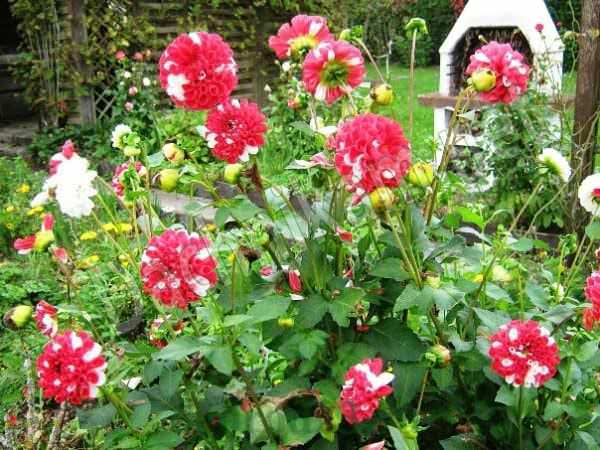

In this case, it is necessary to alternate organic fertilizers with mineral fertilizers. When the first buds appear, potash fertilizers and superphosphate are applied. Mulching an area with dahlias, in addition to protecting plants from slugs, will give you the opportunity to abandon such tedious tasks as weeding and loosening the soil, and also prevent the soil from drying out quickly on hot days.
Dahlias should be watered abundantly 1-2 times a week (unless it rains), but do not let moisture stagnate in the roots: dahlia tubers are prone to decay. In extreme heat, hilling after watering helps to retain moisture. Before the next watering, the soil must be shaken off from the stems, the plants must be watered, and then the soil must be piled up again.
What fertilizers are needed
Dahlia care includes root feeding. The first time is fed 10 days after planting. For the first feeding, insist on a mullein or pick herbs and make green tea - fermented weeds, drenched in water. Herbs are good for tea: thistle, nettle, bindweed. Infuse tea in the sun for at least 3 days, add 0.5 liters of infusion to 10 liters of irrigation water.
Important! Excess nitrogen affects flowering, it becomes less intense. Excessive nitrogen degrades the quality of tubers.
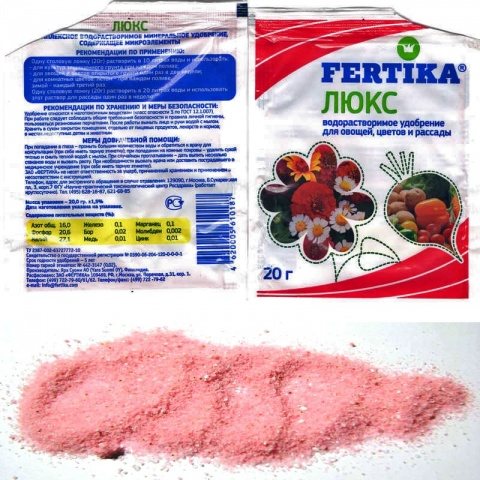

It is important to feed the bushes during the appearance of buds in early July and in August at the end of summer. Top dressing should be carried out after scheduled watering. The best time for watering and fertilizing is the evening after 17-00. For better flowering, you can use:
- Uniflor Bouquet;
- Fertika Lux.
Dahlia feeding
In order for tall dahlias to have enough strength for both vegetative mass and abundant flowering, they must be fed. For these purposes, infusion of mullein is often used.
It prepares like this:
- 1 bucket of manure is bred in 3 buckets of water and insisted for about a week under a lid.
- An unpleasant odor can be neutralized with wood ash by adding 1 kg to the infusion.
The finished product is diluted with water in a ratio of 1: 3 and top dressing is carried out immediately. Such procedures should be carried out every 10-12 days. You can use not only mullein, but also bird droppings, the benefits of which can be read here.
When the first inflorescences form on the bushes, dahlias begin to feed with phosphorus-potassium fertilizers. And approximately, in the middle of August, fertilization is stopped. In addition to fertilizing, plants must be watered in a timely manner, especially during the formation of buds.
The soil under the dahlias is loosened, weeds are removed. But besides this, they also carry out pinching of plants, pinching of buds, and tying up the shoots. To get large flowers, usually 1, 2 or 3 dahlia shoots are formed, and the rest are cut out. For the formation, of course, the strongest and largest shoots are left.
You can get large flowers by pinching the buds. Dahlia inflorescences, most often, consist of three buds. Pinch the middle one, growing on a short pedicel, and leave the other two.
Care rules
During the growing season, the plant needs full care, which fully affects the characteristics of its flowering:
- In flower beds with dahlias, planting and maintenance of which can be carried out on any site, it is necessary to regularly remove weeds. This is due to the fact that they are not only displayed on the aesthetic qualities, but also draw in microelements useful for the plant.
- In the summer, when the plant is actively blooming, it needs timely watering. Florists recommend moderate watering every day in the evening. At the end of August, the frequency of this procedure is halved.
- If the soil is too waterlogged, damage to the tubers of the plant is observed. That is why the gardener must ensure that water does not stagnate near the bushes.
- If the weather outside is dry, then this leads to rapid evaporation of moisture. To avoid this, it is necessary to mulch the soil in a timely manner.
- During the growing season, it is recommended to fertilize the plant. Florists who know everything about dahlia recommend fertilizing with mineral or organic compounds. Most often, mullein tincture is used for this purpose. To prepare it, you need to take one liter of mullein and dilute it in 10 liters of water. Fertilization under the crop is carried out during the watering period.
- Poultry manure can be used to fertilize the crop. For this purpose, it is necessary to take two liters of infusion and dissolve in a bucket of water. One and a half liters of fertilizer is relied on for each piece.
- During active growth of the plant, there may be a lack of nitrogen in the soil. In this case, ammonium nitrate is used to enrich the soil. It is recommended to sprinkle 15 grams of fertilizer per square meter of a flower bed. It is best to do this before watering, which will ensure an even distribution of the fertilizer.
- After the first buds appear on the plant, it is necessary to use superphosphate or potassium compounds to fertilize it. To do this, you need to take one bucket of water and dissolve 30 grams of fertilizer in it. It is recommended to apply it under the roots of flowers every two weeks. During the period of potash fertilization, the use of nitrogen or manure is strictly prohibited.
- The plant has hollow stems. If the height of the plant is significant, then under the influence of the wind, they can break. To avoid such consequences, the bushes are tied up. If the stem was recently broken, then it is subject to rehabilitation. For this purpose, a tire is made from the branch and tied at the place of the stem break. After a certain period of time, as a rule, a resumption of its growth is observed.
- To ensure the decorative effect of the buds, excess shoots are trimmed. For this purpose, the lower lateral branches and stems that grow from the root collar of the bush are removed. During the period of pruning the bush, several of the strongest shoots are left. Cutting off stepchildren is carried out before the appearance of inflorescences on them. They can be used to breed dahlias. Buds that have already faded or deteriorated should be pruned.
- Pruning dwarf dahlia varieties is not recommended, as this can negatively affect their aesthetic qualities. Also, do not prune single plants.
- The flower grower must pay a lot of attention to the hilling procedure. This will not only ensure the full penetration of oxygen to the roots of the culture, but also ensure the full maturation of the tubers until the end of summer. Water the plant a few hours before this procedure.
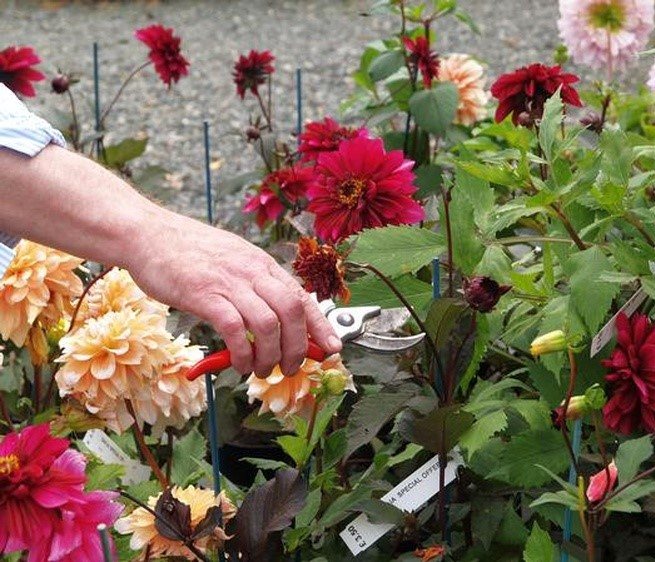

For planting dahlias, you must use only full-fledged tubers.It is in the previous year that full care of the plant is provided.
Formation of a bush of perennial dahlias
To get a beautiful bush of perennial dahlias, you need to periodically care and prune. The best way to get large inflorescences is to trim excess shoots. You can leave only 3-4. It is imperative to remove faded buds so that they do not interfere with the flowering of others.
Also, in tall varieties of dahlias, you need to remove the lower shoots. They can later be used as cuttings for planting. Also, all perennial dahlias need support, so they need to be tied up in the process of flower growth.
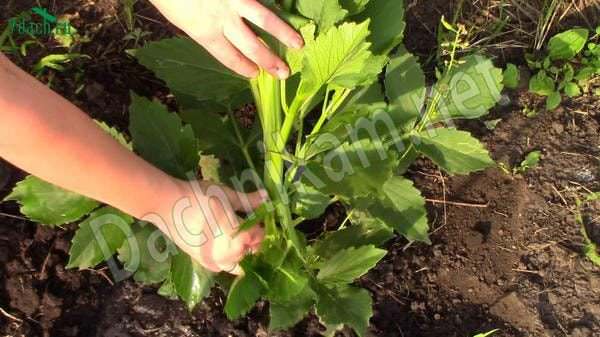

Conditions for growing dahlias
A properly chosen place for culture is the key to good flowering and growth of dahlias. When choosing a planting site, you should consider the location of the flower garden, access to sunlight, soil fertility and moderate moisture levels. Flowers actively grow on a hill, especially where the sun's rays fall on them in the morning.
Choosing a planting site in the garden
Dahlias do not tolerate strong light or dark places, or drafts. Therefore, for them, the optimal landing site is areas with partial shade and free air circulation. If the bushes of the plant are planted in the shade, the flowers will grow stunted and with faded inflorescences.
Do not plant dahlias in areas subject to strong winds. Although the flower has a strong, flexible stem, it will deform and tilt under the influence of the wind. As it grows, the bush will bend and lose its decorative appearance.
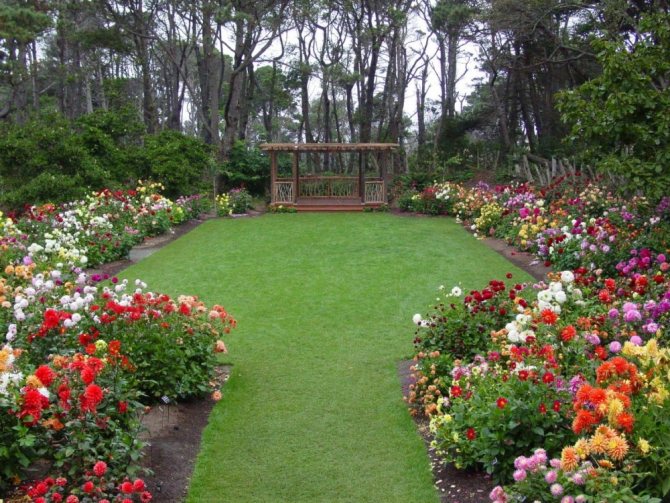

Advice. Recommended the dahlia planting site change every year... And so that the plant does not degenerate and does not hurt, the site for the bushes should not be used for three years. Also, you should not plant dahlia where plants and vegetables sick with fungal diseases grew.
When choosing a site, you should take into account the moderate level of soil moisture. Lowlands, where excess moisture and cold air accumulate, as well as soils with high groundwater levels, are not suitable for distant areas. To create a normal level of moisture in the soil, a drainage layer of expanded clay, crushed stone or broken brick is built. In the beds, it is located below the root system.
Ground requirements
Dahlias require loose, fertile soil with sufficient nutrient content to grow. This requirement for the land will provide good water and air permeability for the normal nutrition of flowers.
Best soil composition - loams, black earth or sandstones filled with fertilizers. Before planting the dahlia, fertilizer is poured into the hole. The acidity of the soil is regulated in one of two ways:
- if pH = 5 or lower, slaked lime is added to the ground;
- if pH = 8 or higher, peat is added to the ground.
Good air permeability of the soil is mainly relevant for perennial crops that form tuber roots. Annual species are not very demanding on the structure of the land.
Dahlia pests and diseases
Earwigs, caterpillars, spider mites, horseflies and aphids are the most dangerous plant pests. When they first appear, the bushes every seven days in the evenings are recommended to be treated with a decoction of celandine or wormwood. For aphids, you can use a soapy solution. If there are many pests, then treatment with insecticidal preparations is necessary. Young shoots attract slugs, which usually appear during the rainy season.
Slugs, for example, are very fond of young dahlia stems, so you can protect the plant's bushes by sprinkling the soil around each bush with a slug repellent. If there is a lot of wireworm in the soil, then chlorophos is embedded in it with a rake. Virus-induced patchy and mosaic wilting is not treatable.In order not to infect other plants, the diseased bush is dug up and burned along with the tubers.
Tuber preparation
Depending on whether you got the dahlias from the underground or bought them in the store, there are peculiarities of their preparation for landing in the ground. During winter storage, tubers usually dry out, some of them show signs of disease. In order for dahlias to sprout well in the future and bloom in unison, they must first be germinated correctly so that the dormant buds wake up during storage.
Taking out tubers from the basement, cellar, they are left for 2-3 days in a cool, and then warm room, so that the plant gradually adapts.
The benefits of dividing tubers
Dahlias are a corm plant that produces many tubers every year. To prevent dahlias from thickening, in the fall, after being dug out of the ground, they are divided into several parts. Or it is done in the spring, shortly before planting in the ground. Many may ask the question: why divide the tubers, they will still grow and bloom anyway?
When there are many shoots from one hummock, the growing stems will shade themselves. And planted in one hole, they take a lot of nutrients. A large number of stems will result in poor flowering. If the bush is not divided, then some of the buds coming from below did not have enough strength to break through to the top. They will simply perish and not rise. Hoping for more flowers, there may actually be much fewer flowers and the flowers themselves will not be as large.
Planted in small bumps, the plant will receive a sufficient amount of nutrition, thereby the stems become more powerful and more flower stalks will grow on them.
How to properly divide tubers
- They start dividing when small sprouts have appeared. Know that when large sprouts grow, there is no longer any point in dividing, because after dividing the plant will hurt, even die, and flowering occurs much later.
- Tubers are first separated by hand carefully. And then cut with a sharp knife along the root collar so that only 1-2 sprouts and 2-3 tubers remain for planting. This is the best option for planting.
- On the divided parts, a dry stem, thin roots, dried and diseased tubers are removed. Allow the cut areas to dry for a few minutes. Then the places of the cuts are treated with brilliant green. You can powder the sections with crushed charcoal, ash, or crushed activated charcoal tablets to kill any remaining fungal spores and bacteria.
- For disinfection, tubers are soaked for 30 minutes in a weak solution of potassium permanganate, ready-made fungicides, in phytosporin. The disinfected tubers are washed with clean water and allowed to dry.
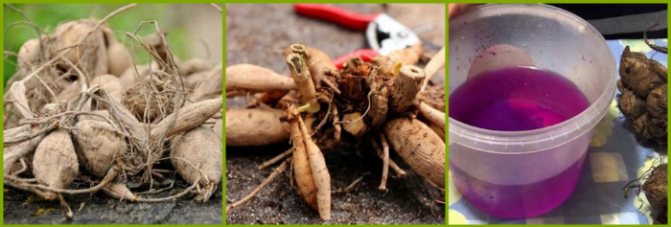

Sprouting tubers
For germination, it is not at all necessary to use nutrient soil. For this purpose, use
- coconut extract,
- wet sawdust,
- vermiculite,
- river sand.
A substrate is poured onto the bottom of the container with a layer of 2-3 cm, moistened, if it is dry, the tubers are placed on top. The substrate is again poured on top so that the buds are on the surface of the soil or flush with it. Germinated at room temperature.
Care for germinated tubers is reduced to regular watering with a small amount of water. Excessive moisture is not required, as it can lead to decay of the roots. Water as needed with Fitosporin solution.
Digging up perennial dahlia tubers
For the winter, the tubers of perennial dahlias are dug up, and this must be done before the onset of frost. First, the shoots are cut off from the plants, leaving them about 15 cm high. The tubers are dug out carefully, trying not to damage them. After taking out the tubers, they are shaken off the ground and dried on the surface for a while, then healthy ones are selected and stored in a cellar or other suitable room.
Before laying for winter storage, the tubers can be treated with a solution of lime or ash from diseases. During storage, the tubers of dahlias are examined and removed from the storage by the sick.The easiest way to propagate these flowers is with tubers. In spring, as well as on potato tubers, "eyes" appear on dahlias, from which shoots will later grow.
It is necessary to divide the dahlia tubers in time so that these young sprouts do not break off later. The division of tubers is carried out in March, having brought them home from storage. But first, it is recommended to soak the tubers in water for 10-12 hours.
Divided nodules are planted in seedling boxes with any moist soil, leaving the neck open. The temperature in the room where the dahlias germinate should be at least 15 degrees. When watering the tubers, you need to try not to get into the cut of the root neck.
In late spring, the tubers of the plants are planted in the garden. In this way, dahlias are propagated for no more than 2-3 years. After this period, the tubers begin to degenerate, and the flowers become much smaller. Therefore, further flowers are recommended to be propagated by cuttings. I will talk about this method of breeding dahlias in one of the following articles. So stay tuned for site updates.
Dahlias do not tolerate low temperatures, so they need to be dug out for winter storage. Having dug up the flowers, you will be able to assess how large their tubers have become, whether they are sick, whether they are spoiled by pests. In addition, you can divide the tubers and plan for replanting them to a new location next year. Dear gardeners! Dahlias are the favorite flowers of many summer residents.
With proper care, they can delight with large flowers of all kinds of colors.
Germination process
When to plant dahlias? The procedure should be carried out in the spring. It starts with sprouting tubers. To do this, the florist needs to perform a number of specific actions:
- After the weather outside stabilizes and the possibility of frost is excluded, it is necessary to select a site for sprouting tubers. Here you need to dig a trench, the thickness of which is 40 centimeters, and the depth is 20 centimeters.
- It is recommended to initially sort the tubers by type, and then put them in the prepared recess.
- Dahlia bulbs are sprinkled with earth and covered with plastic wrap on top. Thanks to such actions, greenhouse conditions are provided for the plant, which guarantees the fastest possible germination.
- To fix the film along the edges, earth is poured on it or stones are placed.
- Germination of buried tubers is observed for 2-3 weeks. Watering the tubers is not carried out, since there is a sufficient amount of moisture in the soil.
- After the first green shoots appear above the surface of the soil, it is necessary to remove the plastic film from the culture. Otherwise, due to the greenhouse effect, the plant will burn out under the influence of sunlight. To avoid freezing of sprouts at night, the culture is covered with a film.
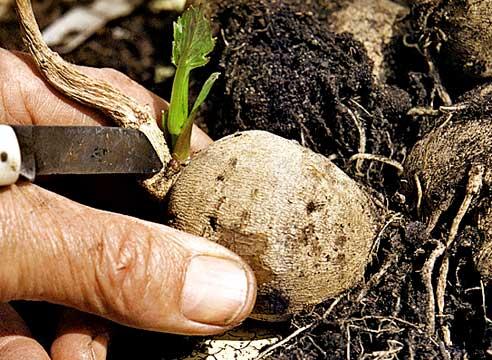

This ends the germination of tubers after winter. Some tubers may not sprout, which means they need to be thrown away.
Preparing perennial dahlias for winter storage
Discard tubers with rot or deep passages that go inside: you will never guess who may be sitting in the depths of this passage. Discard single rootless tubers. The likelihood that they will grow again is very small. It is better to dig with a pitchfork so as not to accidentally cut them.
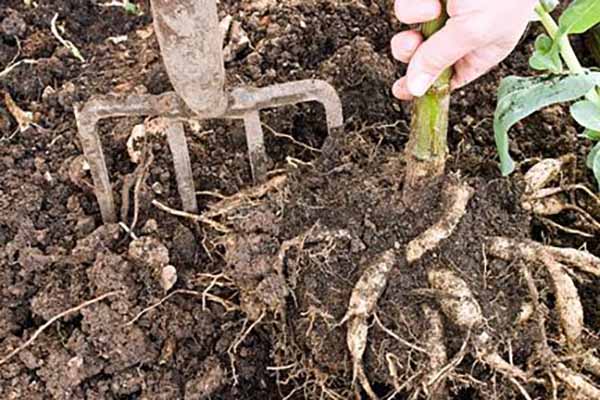

Just pry the soil with a pitchfork and carefully remove the entire tuberous ball. Shake off dirt particles. Cut off the stem and leaves (they can be sent to the compost heap). Now the tubers need to be dried in the sun during the day. When dry, shake off the dirt again.
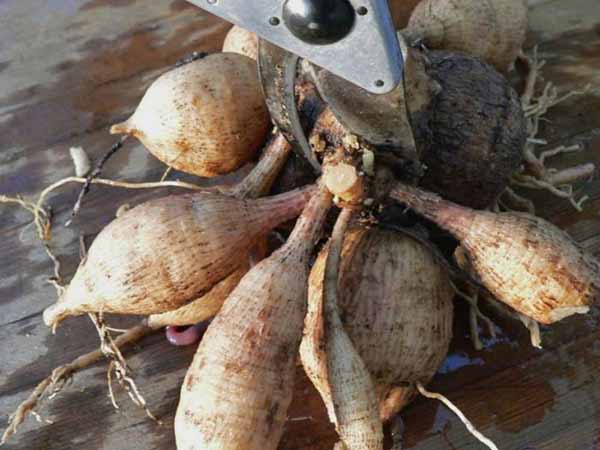

You can rub them gently with your hands. Mark the variety or color of the dahlias you dug. For example, tie a string with a plastic or wooden tag to the tubers. The remaining stems of dahlias should be no more than 3 cm so that they do not start to rot in winter.
A large cardboard box is suitable for storing dahlias.Place the tubers in it at a distance from each other to exclude infection. If any of the tubers does start to rot.
Sprinkle the peat over the tubers. If the box allows, you can add another layer of tubers with peat. Instead of peat, you can use sawdust or feed pellets. The medium used should protect the tubers from drying out and excessive moisture.
That's it - the dahlias are ready for wintering. They should be stored in a cool place where there is no frost (for example, in a caisson or cellar), but many are also stored in the refrigerator, this type of storage takes place, but you always need to understand that modern refrigerators dry the air and this can affect the bulbs.
Landing dates
There are no specific dates, since everything depends on the climatic zone. From the practice of experienced flower growers, it is believed that the most suitable time for planting dahlias in open ground, regardless of weather conditions, is the period from late May to early June.
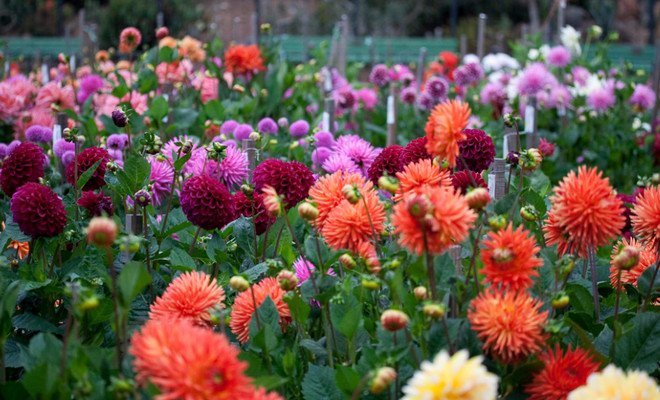

With early planting, dahlia tubers may freeze and not emerge on cold days in early May. If planted later, in the midst of a hot summer, immature flower shoots will burn out at the end of July.
With the onset of stable normal temperature conditions, without the threat of sudden frosts, dahlias are planted in the first half or mid-May.
Did you know? The word "dahlia" appeared in 1803. It was invented by the botanist Karl Wildenov, who gave this name to the flower in honor of the academician from St. Petersburg, botanist, geographer and ethnographer Johann Georgi.
Dahlia variety "Funny guys"
Dahlia variety funny guys belongs to the dwarf form of dahlia. Although the dahlia variety is considered an annual, it is very popular and in demand among flower growers. Their height ranges from 25 to 70 cm. The name "Merry Guys" comes from the bright and varied color of flowers. The main breeding method is seeds. The stems of the plant are quite strong, the leaves are bright green in color.
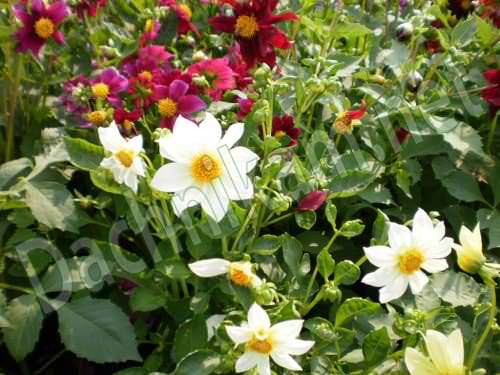

In some cases, they can be brown-burgundy, which is typical for dahlias with dark red flowers. There are plants with simple, double or semi-double petals. They are white, pink, yellow, red, lilac, burgundy. Dahlia "Merry Guys" is a rather unpretentious look. They grow quickly and delight with their bright colors for a long time. It is not difficult to grow a dahlia in the garden.
Buying tubers in packages
When buying dahlia tubers in the store, be careful. If possible, carefully inspect the tubers, sometimes there are a lot of broken off, dried nodules in the package. You should not buy large nest bumps, they will grow a lot of tops and few flowers. When buying, pay attention to the size of the tubers, and also
- tubers must be dense and firm;
- are light brown in color;
- there are no dry and fallen tubers in the package;
- there is a small piece of the root collar - the place where the root passes into a tuber;
- the presence of growth points - sprouts.
Based on these signs, you will buy healthy planting material. And then the purchased nodules are prepared for planting in the same way as described earlier.
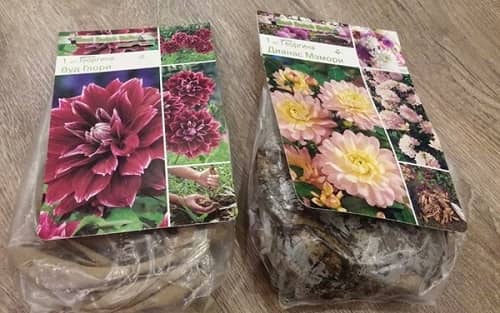

Dahlia planting tips
I am happy to share with readers tips for growing my favorite dahlia beauties. I split dahlia tubers about seven days before planting. And I plant it when there is no longer a threat of frost in our Don region. About a week before that, sprouts the size of a half or little finger should appear on the tubers (this depends on the size of the tuber).
When there are several varieties, I carefully, trying not to scratch the surface, write their names directly on the tuber with a soft simple pencil, carefully cleaning it from the remnants of the earth. I spread the tubers to the light, spreading them out on a substrate of wet peat or raw sawdust. There can be two or three sprouts on a tuber; in the light they quickly turn green and get stronger.
Three days later, I spray them with water (or maybe a weak solution of some fungicide) and after another three or four days "dahlia" can be planted in a street flower garden. If there are at least two tubers in the cut, the plant will bloom in the same year. Thanks to cuttings for the new season, you can get a large amount of planting material, as well as rejuvenate old plants.
Perennial dahlias cut well
To do this, I extract the sprouts of tubers with buds that have already turned into sprouts into the light and, when the sprouts turn green (and this can happen in two days), I separate them from the tubers with a sharp knife. After a short drying, I plant such a stalk in a small 150 ml glass and cover it with a transparent bag.
All this should take place in the light.
The sprout separated from the tuber should be at least 5 cm. Such a stalk takes root well and after a week can give roots by itself, without any stimulants. In early summer, I transplant the cutting into the garden. This season it will not bloom, but next season it will.
Useful Tips
You can bring the beginning of flowering closer and increase its duration by germinating dahlias before planting and caring for them throughout the summer. Summer care includes:
- watering;
- top dressing;
- bush formation;
- disease prevention and treatment.
Tuber preparation
Before planting dahlias with tubers in a flower bed, they must be removed from storage in early April and revised. During the preparation of dahlia tubers for planting, you need to:
- cut out damaged areas;
- cut off dried roots;
- anoint the wounds with brilliant green or sprinkle with crushed activated carbon.
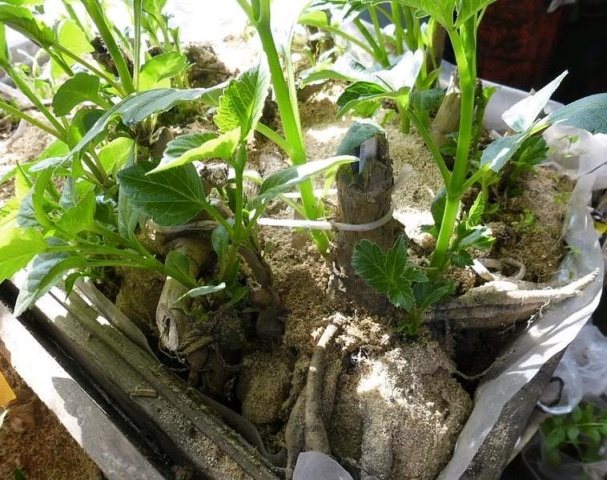

Prepare a high container for germination, pour peat or soil into it. Spread the tubers over the surface, lightly press into the soil. Part of the tuber (2-3 cm) should rise above the ground. Place the box in a well-lit room, where the air temperature is maintained around 18 ° C.
Advice! Use clean tubing tools.
You will need a pruner and a sharp garden knife. Before planting, soak the tubers in a solution of karbofos for 2 minutes.


After about 2 weeks, the buds will swell on the tubers. After their appearance, the tubers can be divided. Each section must have a well-developed kidney and root collar. Delenkas can be kept in boxes for a short time, waiting for when it will be safe to plant dahlias in open ground.
Landing
Planting holes are made after waiting for warm weather (15-20 ° C), at this temperature, and dahlia tubers are planted in the soil. Leave the interval between the holes at least 40 cm. Make a deep hole (40 cm), spill it with phytosporin, add ash, humus.
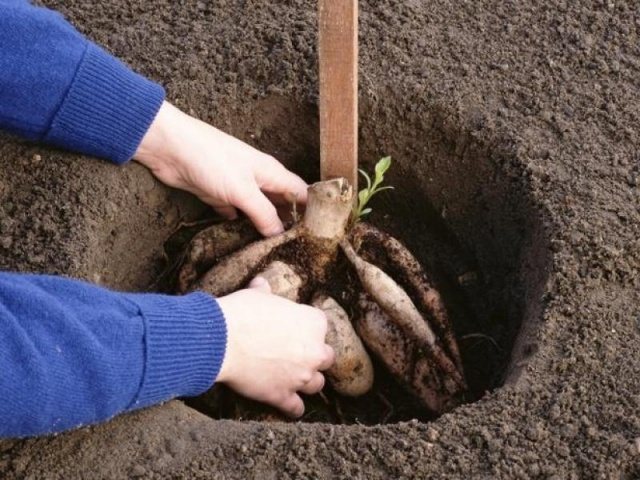

Now about how to properly plant dahlias in the holes. For tall varieties in the northern part of the hole, you need to score a stake. For stability, it is slaughtered to a depth of 40 cm, the tubers are laid out around the support, the necks of the tubers should be in the ground. The soil thickness above them is 5 cm. After that, water the wells well. On the stakes you need to attach tags with the names of the varieties.
Plant dahlias by height
How to plant different varieties of dahlias that differ in the growth of the bush. To make the flower bed pleasing to the eye, tall varieties are not planted nearby and undersized varieties. Tall plants will jam their shorter neighbors. To prevent this from happening, it is necessary to leave a row spacing of at least 60 cm between the holes.
Disembarkation
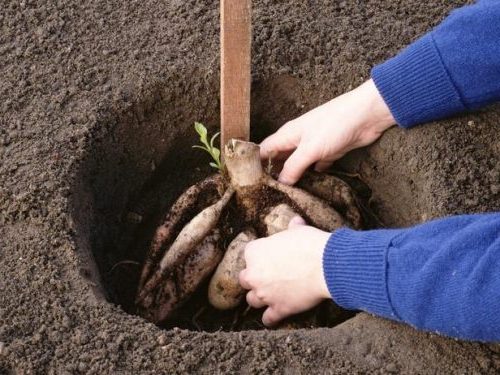

Dahlias are transferred to the soil in April. For planting, holes are dug about 30 cm deep and watered generously. Then you need to add rotted manure mixed with earth to the hole, place the tubers there and cover it with earth. The layer of earth above the root collar should be 3 cm.
When planting dahlia tubers, you do not need to bury them. The top of the rhizomes should rise about 2.5 cm above the ground. This will help to avoid decay of the neck and damage to the tubers.The buds from which new shoots will grow are located near the root collar.
Diseases
Dahlias suffer from such diseases as black leg, viral mosaic, bronze and leaf spot, oak mosaic, gray and white rot, bacterial cancer. The reason lies in viruses, bacteria and fungi. For these diseases, plants can be sprayed with preparations "Topaz" and "Hom". Effectively fighting diseases is possible only by culling and burning affected plants.... Disinfection of soil, gardening tools, pest control and observance of crop circulation also help a lot.
Soil preparation
Dahlias prefer moisture-absorbing, structural soil, which is also highly permeable to water. The wrong choice of soil is very often the cause of the death of dahlias. You can improve the structure of the soil with organic additives:
- humus;
- fresh or rotted manure;
- peat;
- straw cutting;
- compost;
- turf and other materials that are readily degradable in the soil.
In heavy, clayey soils, to improve water permeability, add:
- coarse river sand;
- gravel;
- ash (peat or coal);
- peat;
- coal slag (fine, sieved and washed).
If the site is dominated by sandy soil that does not hold water well and is easily eroded, you can add to it:
- vermiculite or perlite;
- peat;
- clay and other materials to help retain moisture.
Advice: it is not required to clear the soil of gravel or small stones; such additives in any type of soil will not interfere with the normal development of dahlias.
Dahlias are not too demanding on the acidity of the soil and can put up with its excess or lack, but they show the best results on slightly acidic or neutral soils. But strongly alkaline soils inhibit their development and growth. Before planting dahlias, you can analyze the acidity in order to then bring it to the desired indicators:
- at a Ph value of 4-5, slaked lime is introduced into the soil (30-100 kg per 100 square meters);
- at Ph 8 and above, the soil is acidified by introducing peat into it.
The place where the dahlias will grow is plowed deeply in the fall - by 30-35 cm. Then, 2-3 weeks before planting the flowers, the soil is dug up or plowed again, paying special attention to harrowing and loosening.
General information about dahlias
Dahlias are very beautiful perennial flowers. With proper care, each variety can stay with us indefinitely, every year, giving life to a large number of new plants.
Plant structure
Dahlia is a root-tuberous plant, it consists of:
- A thick, hollow stem, which can reach a height of 20 cm to 1.5 m or more. It is quite durable, but the weight of the flowers and strong winds can break it.
- Inflorescences-baskets, the diameter of which ranges from 3 cm in dahlia-lilliputians to 25 cm and more in tall varieties. It consists of marginal ligulate flowers, which have a wide variety of colors and inner tubular flowers, most often yellow. Depending on the variety, the inflorescence can consist only of marginal flowers or have modified tubular flowers.
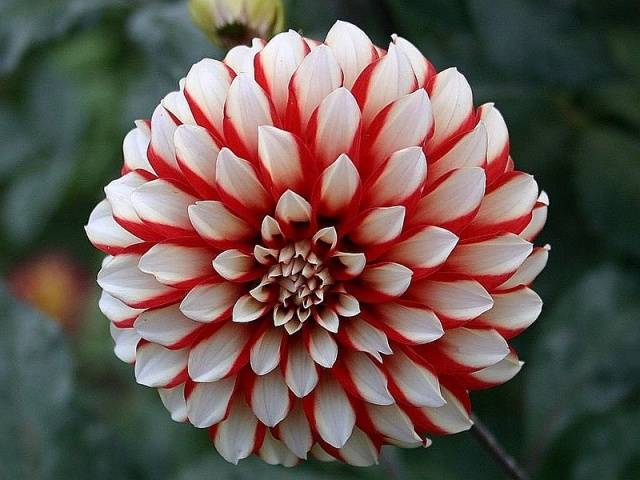

- The root system, in dahlia, is represented by root tubers or root cones, which are actually thickened modified roots.
- The root collar directly above the tubers. It is from her that dahlia stems grow. It is very important for the flower; it cannot be cut off during the autumn digging, since the entire plant dies when the root collar is removed.
Dahlia life cycle
Only dahlias grown from seeds or cuttings behave like ordinary plants, and even then only in the first year of life. As they grow, they form a small nodule, which can be dug up and sent for storage for the winter, like large tubers of adult plants, and then they will need to be looked after like other flowers grown from a tuber.
With the beginning of the growing season, dahlias first of all wake up root tubers. Growth processes begin in them, first buds appear on the root collar, and then shoots. They do not need to be germinated, but can be planted directly into the ground with the onset of stable warm weather. But flowering will then begin late, perhaps only at the end of August.
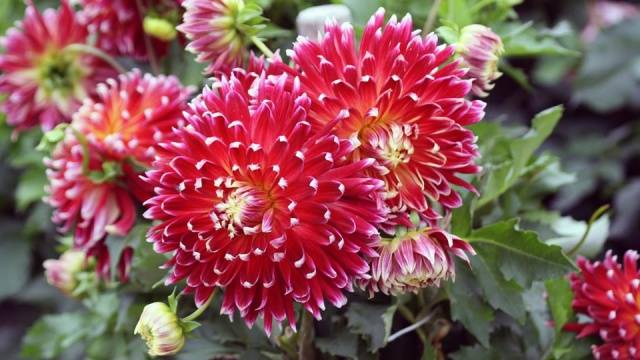

After planting, dahlias grow, bloom, form seeds, and after the first frost, the green mass dies and they urgently need to be dug up, cleaned, cut off, keeping the root collar and sent to rest. It is best to store the tubers at a temperature of 5-8 degrees.
With the onset of spring, under the influence of heat and light, the root cones wake up, and everything starts all over again.
What dahlias love
What do dahlias love? We need to know this in order to grow the best flowers without losing the tubers that will give life to new flowers next season.
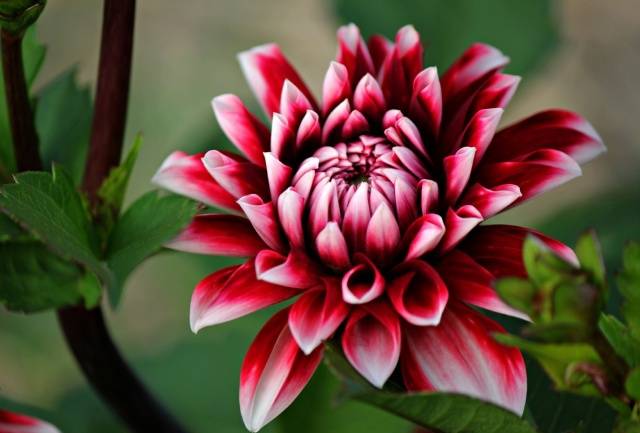

- Dahlias love warmth. They do not tolerate the slightest frost and do not winter here even in the most southern regions.
- Dahlias love light. They may be able to grow in poor light, but the stems will be elongated, pale, the flowers are scanty, small and poorly colored, and the tubers are small, weak, and may well not survive the winter.
- They need moderately fertile soils, water and moisture permeable. The flower will grow everywhere except wetlands, but you will get the best results on light loam or on well-fertilized sandy soils.
- Dahlia bushes should be well ventilated. This does not mean that we should plant flowers in a place open to all winds. On the contrary, dahlias need to be protected from the wind. Just when planting, you need to take into account the future habit of the bush and not plant them too close to each other.
- Dahlias require moderate watering. Watering should be sufficient, but not excessive. Here you need to adjust. We will talk about the intricacies of watering on different soils below.
Comment! The new dahlia undersized container varieties are more drought tolerant than other varieties.
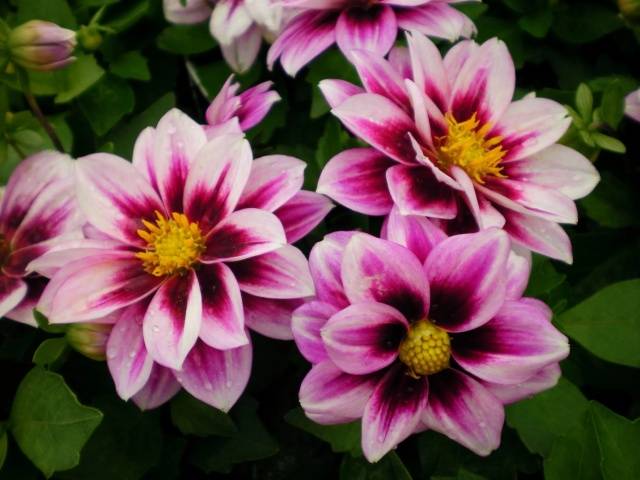

What dahlias don't like
Although dahlias are considered very unpretentious flowers, there are things they will not tolerate.
- First of all, this is non-observance of wintering conditions. A dahlia can tolerate large deviations from ideal conditions, but leaving it in the ground, even under the most beautiful shelter, or planting it in a pot, putting it on the windowsill and continuing to water is impossible - the only result we get is the death of the flower.
- As we already wrote, a dahlia will not grow without light. And if it does, it won't be long.
- It is strictly forbidden to overfill the plant. Its main organ is the root tuber, if it decays, the flower will die.
- The plant does not like fresh manure and increased doses of nitrogen fertilizers.
- You should not plant dahlias in places where there is often a strong wind, and even without a garter.
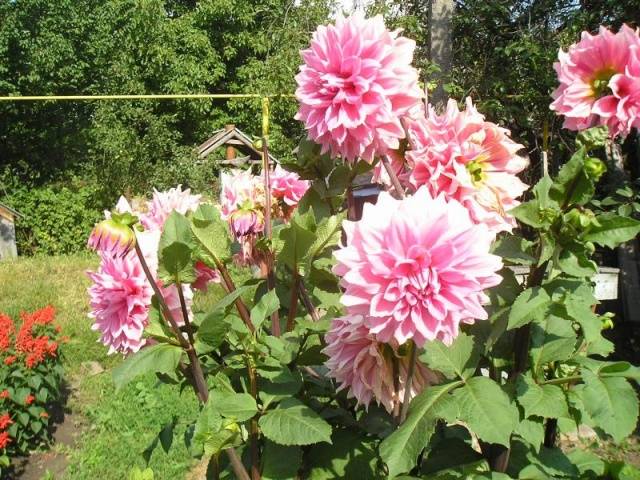

Dahlias from cuttings
Another method of planting dahlias is the cuttings method. It allows you to get up to 50 seedlings from one root tuber. Plants grown in this way are superior in decorativeness in terms of flowering and vigor of development.
Germination conditions
To obtain cuttings from a tuber, the pot with planting material must be placed in a warm, well-lit place. The tuber with buds should be planted in a container with a mixture of soil, humus and sand, while the tuber should be covered with earth, and the neck should be above ground level. With good lighting and regular irrigation, the cuttings are stocky with small internodes.
How to cut a stalk correctly
You can remove the stalk from the tuber root when the sprout grows 10-15 cm.This is done in two ways:
- carefully break off the stalk (it will turn out with a "heel"), when a piece of tuber is captured together with the shoot;
- cut with a knife at the base of the tuber.
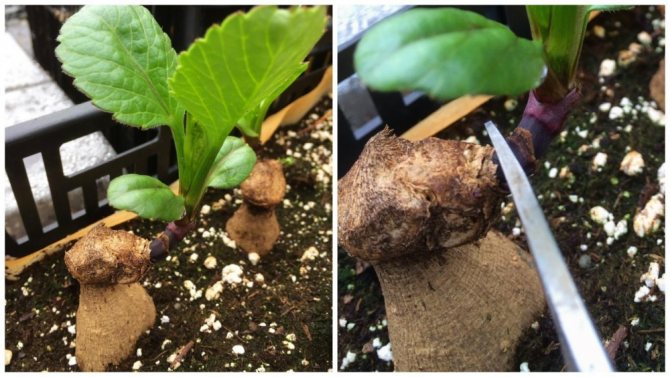

Cut the cuttings should be held for several minutes in a solution of succinic acid or a root formation stimulator "Kornevin". With the first method, the cuttings take root faster, and subsequently give full-fledged tubers. New replacement buds appear at the site of the cut at the tuber. With the second method, the cuttings will also take root and give good flowering. Young shoots on the tuber will be ready for cutting in 3 weeks.
Digging and storing in winter
Starting from the end of September (it is possible later, depending on the climatic conditions of the region where the dahlias grow), when the stems die off, the tubers must be carefully removed from the soil and placed in the necessary conditions for the whole winter, so that they can be planted back into the ground with the onset of spring. It is important to know that dahlias should not be planted in the same place for more than three years in a row. The stems are cut 10-15 cm from the ground. The tubers are dug up in dry weather. First, they are dug in at a distance of 30 cm around. For digging, you should use a pitchfork - they poke the tubers and pull them out of the ground.
Then they need to be shaken off, washed from the soil and dried for 4-5 hours in the sun or two days indoors. It is also advisable to pickle the tubers. For this procedure, potassium permanganate or means of the type "Maxim", "Vitaron" is suitable. After dressing, the tubers also need to be dried.
Well-dried tubers should be kept in a room with a temperature + 2–7 ° С or in the refrigerator. They are placed in a box or plastic bag with peat, sawdust, sand. Can also be wrapped in plastic wrap.
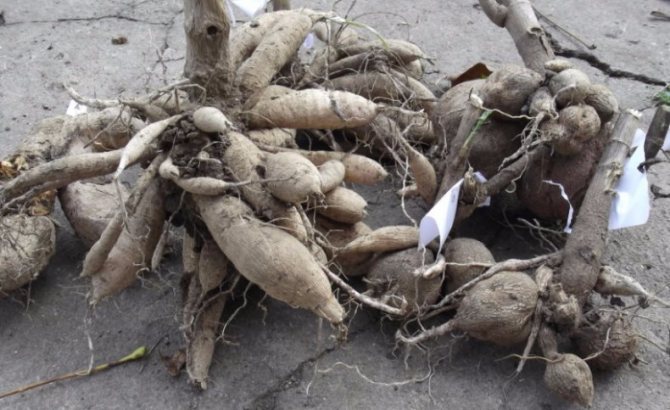

Tubers should be periodically ventilated and examined for rot.
By planting the most beautiful dahlias of different varieties and colors in any corner of your garden or summer cottage, you can create a unique style for your yard. They are especially beautiful in combination with irises, peonies. Unusual for a single planting against the background of lawns.
To help them reach the largest inflorescence sizes, the brightest petal colors, the highest stem length and stability, correctly conducted agricultural techniques, which are absolutely simple and accessible even to people who first decide to plant a flower garden, will help to avoid diseases and parasites.
Description
Dahlias are spectacular flowers in a wide variety of shapes and colors. The flowering period begins in mid-July and lasts until the first frost. Dahlias can be found not only in summer cottages, but also in city flower beds.
The inflorescences of the flower are collected in baskets with a diameter of 5 to 30 cm, consisting of many pointed petals. Depending on the variety, the shape and size of the baskets differs. And the color of the petals varies from snow-white to deep burgundy. Breeders are constantly working to create new hybrids, which are used in landscape design to decorate personal plots. Florists create original bouquets and flower arrangements from dahlias.
The plant is popular among flower growers due to its long colorful flowering and unpretentious care. In addition, dahlias can be grown in pots, decorating verandas, balconies and loggias.
Features of planting annual dahlias and caring for them
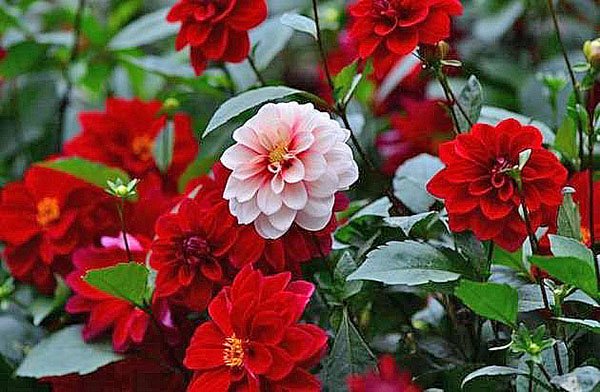

Annual dahlias, planting and caring for which are easier than perennial varieties, are the optimal solution for novice gardeners. These varieties are also suitable for colder climates where there is no way to grow plants in a greenhouse. In terms of beauty and abundance of flowering, they are not inferior to perennial dahlias and have a large number of varieties and varieties.
Variety of dahlias
Among a large number of crop varieties, there are giants, the stem height of which exceeds 1 meter, and miniature plants in the form of small compact bushes. However, the main feature of the classification is the structure of the inflorescences (Figure 2).
Based on this, the following groups of Daliy are distinguished:
- Single row (simple)
- Collar
- Anemone
- Peony
- Spherical
- Decorative
- Pompom
- Cactus
- Semi-cactus
- Lotus (nymph)


Figure 2. Some popular types of flower (from left to right): collar, peony, globular, cactus
TO GROW GEORGINS - YOU NEED TO KNOW THEIR FEATURES
Dahlias are thermophilic plants. They cannot withstand our frosts, so their root tubers are dug up every year and stored until next summer. A great advantage of the plant is its shade tolerance. Dahlias will grow well even in completely shaded areas, as long as the soil is fertile and neutral. On acidic lands, they will simply die.
Plants cannot stand the close standing of groundwater and rainwater, so they are planted in flower beds at least 35 centimeters high, buried 15 cm in the ground. They are planted only in well-heated soil when the spring frosts are over. The best landing dates are from 3 to 10 June. Tubers purchased in advance can be pre-germinated in pots.


Perennial dahlias in landscape design, combination with other plants
Dahlia is the king of landscape design. Due to the richness of species, colors, it occupies a leading position in the creation of flowering mixborders. The splendor of the forms, the color palette allows you to use it in the design of monogamous compositions. Good compact miniature bushes along the sidewalks. Designers use different varieties to create flowering paths along green hedges. Low-growing specimens look beautiful on alpine slides, rabatkas. They are used to decorate terraces and balconies.
Dahlias are unique as they combine with a variety of perennials. An ideal companion for lilies, irises, daisies, chrysanthemums, echinacea, field poppies, lupins. Even the smallest dahlia, which has collected many varieties, evokes a lot of positive emotions. For them, open sunny areas are allocated, viewed from all sides. Large-colored specimens look spectacular in small groups against the background of lawns.
Landscape architects often use varieties that have decorative foliage in various rich shades, for example: dark cherry, red-brown, which emphasize the beauty of bright inflorescences.


Which variety should you choose?
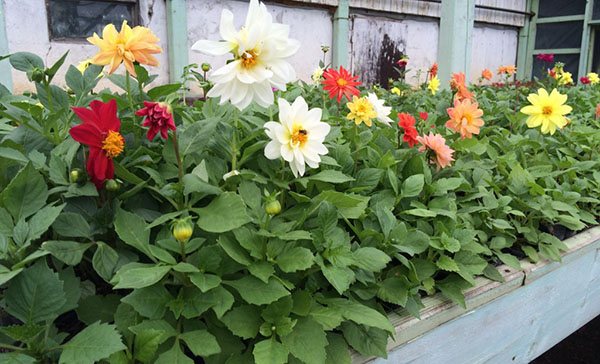

Before planting, you should familiarize yourself with the varieties of annual dahlias with photos and names. Some of them will not grow more than 20-20 cm (undersized), so they are not suitable for decorating bouquets. Tall varieties can grow up to 70-90 cm in height and can form a veritable hedge. Among the most popular varieties of annual dahlias are:
- Figaro is a low bush (up to 45 cm), on which lush multi-colored inflorescences are formed;
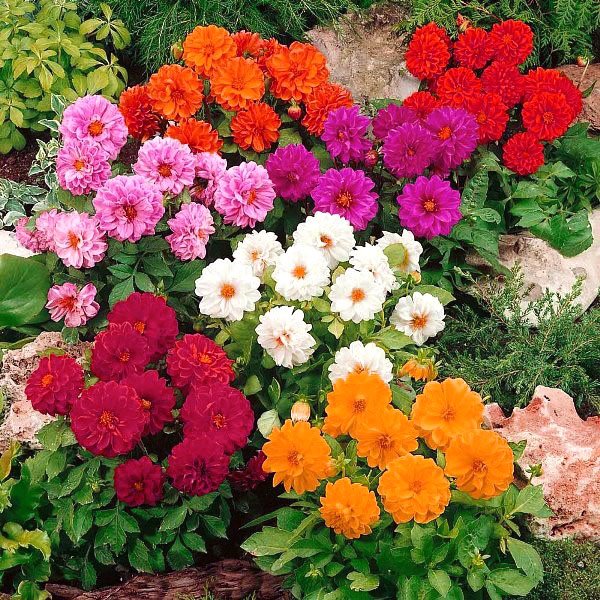

- Piccolo is another undersized bush (up to 40-45 cm), on the flowers of which the core and petals are clearly distinguished;


- Unvins Dwarf is a taller plant, can reach 60 cm.
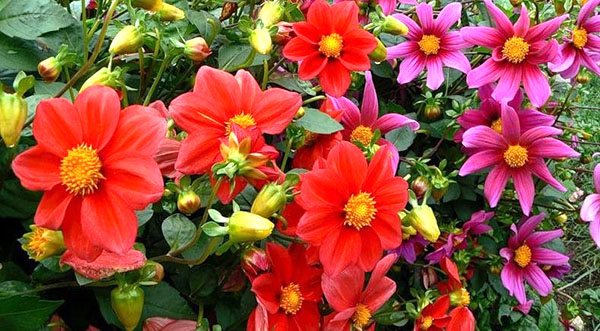

Growing annual dahlias is an easy way to get vibrant flowers with little investment or preparation. Tall plants make beautiful bouquets or hedges, and low-growing annual dahlias form small borders. They are easy to care for, do not require winter preparation and fertilization. In addition, the seeds of the plant can be collected by yourself and left for planting next season.
Annual dahlias in the country - video
Growing in pots
At home, dahlias are grown in pots, which are most often used to decorate balconies and loggias. In addition, containers with flowers can be placed on verandas and terraces, as well as decorate the porch and paths in the yard with them.
For planting in a pot, varieties with a medium-sized root system are chosen, which will feel good in a limited space, for example, "Renoir" or "La Tour".
Pot selection
When choosing a pot for planting, you need to pay attention to its volume.For low-growing varieties, containers with a volume of 5 - 7 liters are suitable, medium-sized specimens need 7 - 10 liters. Tall dahlias require a lot of free space, so a container with a volume of 18 - 20 liters is selected for them.
For planting, you can use regular flower pots, plastic buckets and wooden boxes. There should be drainage holes at the bottom of the container to drain excess moisture when watering.
Experienced growers recommend choosing ceramic pots that allow air to flow to the roots of the plant and prevent overheating. The disadvantage of clay pots is the accumulation of salts of heavy metals and pathogens in the walls.
In plastic buckets and containers, the root system can overheat. In addition, the material is poorly permeable to oxygen, which negatively affects the plants.
Wooden boxes are air permeable and do not heat up under direct sunlight.
Choose a container for planting, preferably light colors, in order to reduce the temperature of the soil. In dark containers, the soil will overheat, which will negatively affect the health of the dahlias and their flowering.
Before planting, the container must be disinfected with boiling water. This will help get rid of pathogens and prevent the development of fungal infections. In addition to boiling water, you can use special disinfectants that do not contain chlorine, such as Desamin.
The planting pot must be stable. Lightweight plastic containers can tip over under the weight of the flower.
Soil selection
Soil selection is an important step in growing a crop. The soil for planting dahlias should be light, loose, well-drained. It is imperative that the soil contains nutrients necessary for flower growth.
Ready-made soil mixture, enriched with the necessary mineral components, can be purchased at a flower shop. Nutrient composition is not the only advantage of industrial soil. Store soils are treated against pathogens and fungi and are completely safe.
If it is not possible to purchase an earthen mixture in the store, you can prepare it yourself. The composition of the soil mixture should include the following components:
- garden land;
- peat;
- rotted manure or humus;
- mineral fertilizers.
The garden soil must be thoroughly cleaned of the roots of weeds, small stones and debris. All soil components should be disinfected for 1 - 2 hours in an oven at a temperature of + 150… + 200 degrees and mix. Before applying mineral fertilizers, you need to make sure that nitrogen is not present in their composition. An excess of nitrogen fertilizers negatively affects flowering processes. You can use special industrial mineral complexes designed for a specific culture.
Landing
Planting dahlias in a pot is carried out after preparing the pot and soil. When all the components have been disinfected, a drainage layer of perlite or expanded clay 10-15 cm high is laid on the bottom of the planting container. Soil is poured over the drainage, leaving about 20 cm to the edge of the container. The soil inside is well compacted and watered with water at room temperature.
The tuber is placed in the center of the pot with sprouts up and sprinkled with earth, without deepening the root collar of the flower. The soil around is well compacted.
The planting container is placed in a warm, well-lit place. Care must be taken to ensure that the seedling is not exposed to direct sunlight and drafts.
For the first 5 - 7 days, watering the plant is carried out from a spray bottle until absorbent roots are formed. Then you can water from the watering can from the center to the edges of the pot.
Follow-up care
Follow-up care for potted dahlias includes:
- watering;
- pest control;
- loosening the soil;
- top dressing.
In hot, dry weather, watering is carried out daily. You can use the bottom watering method by placing the flowerpots in a container of water. Plants will absorb the required amount of moisture, and the drainage layer will prevent the soil from locking. If the pots of dahlias are displayed outside, in rainy weather, irrigation is carried out no more than once a week.
After watering, a crust may form on the surface of the soil, as a result of which air exchange is disrupted. To ensure sufficient oxygen access to the root system, the soil must be loosened regularly.
For normal growth and long-term flowering, plants need feeding. Potash and phosphorus fertilizers must be applied to the soil at least once a week along with watering. Granular fertilizers are spread on the soil surface after moistening. During the period of bud formation, you can use mineral complexes for flowering plants, including dahlias.
Treatment against insect pests is carried out every 2 months with special preparations that can be purchased at a flower shop. Plants are often attacked by aphids, so regular spraying with insecticides helps prevent the spread of parasites.
Popular types
There are more than 12,000 plant varieties in the world, which differ in height, flower shape and size, and color. Depending on the shape, there are terry, non-double and semi-double dahlias. In turn, they are divided into 12 more groups, each of which will be considered in more detail:
- Dissected. They are characterized by rather large flowers. The petals are ligulate, extended forward.
- Orchid flowers. They got their name from the bizarre shape of the reed flowers. Their petals are either extended outward or curled inward.
- Cactus. You will immediately recognize them by their petals, which are rolled into a tube. The flowers themselves are very large and visible from afar.
- Pompom. Such varietal dahlias have short, fairly dense flowers. Reach 5 centimeters in diameter. It is this group of flowers, due to its beauty and attractiveness, that is most often used for cutting.
- Peony and Chrysanthemum. The name is fully consistent with the appearance of the flowers. They look a lot like chrysanthemums and peonies.
- Nymphaean. Unlike other varieties, they have slightly concave false-reed inflorescences. The shape is oval.
- Anemoid. The shape is the same as that of the anemone. Inside there is a disc of tubular petals, around 1-2 rows of reed petals.
- Minion. Minions include annual dahlias. Rarely grow above 50 cm.
- Decorative - with wide tongues.
- Collar. In the center there are tubular flowers, around them - petal-shaped, forming a "collar".
- Spherical. Perhaps the most elegant of all of the above. The double inflorescence forms a beautiful ball.
The most popular varieties in our country are Peaches, Apvil, Royal Dahlia, Doris Day, Genette, Noreen and many others. The mignon group, terry varieties, remains in demand. Low-growing plants are actively used for landscaping balconies, they are planted in ridges and borders. Plus, they look great in flower beds, especially when planted in the front row.
Reproduction of culture
Annual dahlias - planting and care
Dahlias are grown in several ways: by dividing the tubers, by seed or cuttings.
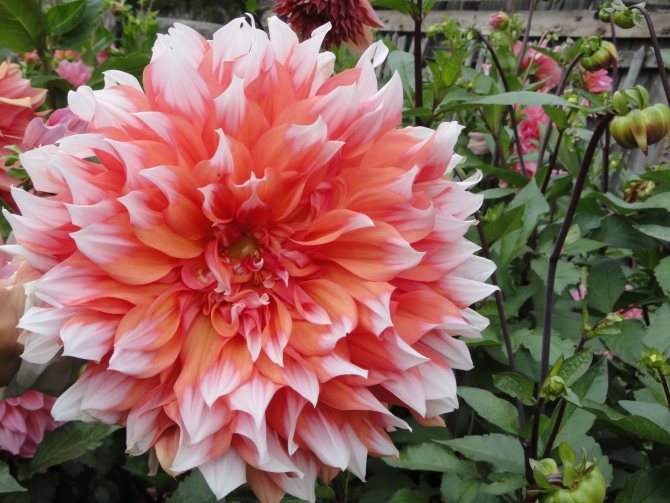

Perennial dahlias
Tuber propagation
After removing the rhizomes in the spring from the storage site, it is necessary to carefully examine the plants, remove dead and dried parts. Before the procedure for dividing the root tubers, they must be lowered for disinfection in a weak 15% solution of potassium permanganate for 30 minutes. The tubers are divided into parts by hand or with a knife so that on each division one or two buds are obtained, placed on the root collar.When cutting the tubers with a knife, cross divisions close to the seedlings should be avoided, as they can be damaged. It is important that the knife used is sharp enough to be disinfected after each cut.
Sections of tubers are treated with a manganese solution or sprinkled with crushed activated or charcoal. The tubers are dried and planted in open ground or in pots with soil in such a way that the buds of the sprouts are 10-12 cm below the ground level. This deepening promotes the formation of new roots - nodules growing from the main stem.
Cuttings
This method is used to prevent the degeneration of a particular cultivar or to accelerate the multiplication of a crop. Cutting allows you to preserve all the best varietal properties of the plant, therefore it is considered the most effective method. To harvest cuttings, the tubers are placed in a warm and bright place, where they begin to actively germinate. On one copy, you can cut off up to three dozen small shoots.
Cuttings must be broken out under the leaf nodes or near the annular (calcaneal) tuberous formation. After that, the sprouts are placed in washed sand. For fast rooting, cuttings are treated with root stimulants. Once the plants are rooted, they are moved into small pots filled with a nutritious earthy mixture and taken out to sheltered places, greenhouses or greenhouses at the end of May. At the end of May, new young dahlias are ready to land on a permanent site.
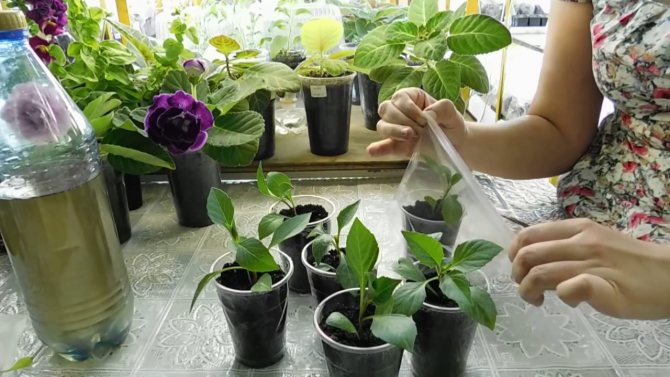

Cuttings
Dahlia cuttings are carried out from February to the end of July. If the cuttings procedure is carried out in early spring, then in this case the sprouts quickly turn into full-fledged flowering plants with powerful tubers. For late cuttings, sprouts in May - July are planted directly in pots, where they will be stored throughout the winter.
Tubers grown by cuttings bloom with larger flowers and have pronounced characteristics of the parent variety. It has been noticed that young nodules are much healthier and of better quality than tubers obtained by division.
Planting rules for planting seeds
The seed method of reproduction of dahlia crops is suitable for those flower growers who do not want to bother with the annual digging of tubers for the winter, worry about creating conditions for their safety.
By planting seeds, you can display undersized, dwarf species of dahlia flowers. New varieties are also bred in this way, however, not as a perennial crop, but as an annual. Sowing begins at the beginning of spring and uses ordinary boxes or containers filled with a peat-sand mixture with the addition of perlite. The boxes are covered with transparent glass or foil and placed in a warm, well-lit place. After about a week, tiny shoots of future beauties-dahlias appear. Seedlings need to be looked after: moisten the ground in a timely manner and periodically ventilate. Such a simple care is carried out before the appearance of the cotyledon leaves. When two or three leaves appear at the seedlings, they are dived into small pots or nutritious peat tablets and placed in greenhouses before planting.
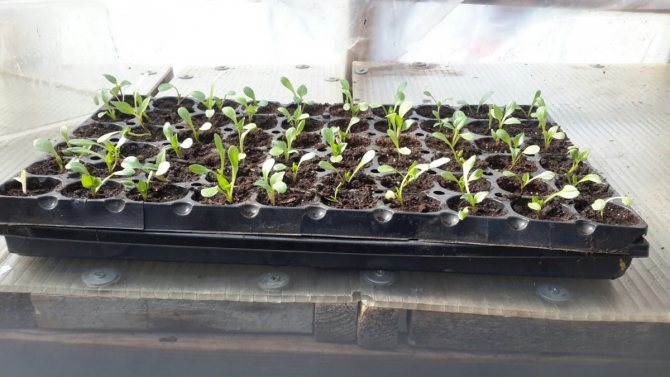

Planting rules for planting seeds
By the month of May, the seedlings will grow up, you need to start hardening and accustoming them to direct sunlight. After the threat of spring frosts has passed, the seedlings are planted in open ground at a distance of 30 to 35 cm from each other.
As you can see from the description, the reproduction technique is not much different from the usual planting of seeds. But there is one peculiarity: it is not for nothing that this flower culture has the full name "changeable dahlia" - when grown from seeds, there is no guarantee that the grown plant will have the same shape and color as the parent.
Forums, reviews
The forums bring together amateur flower growers from all regions of the post-Soviet space.There is no place for political issues, the world of flowers reigns. The issues of purchase and storage of seedlings are discussed;
- advice is given on where, when it is better to plant;
- photos of new varieties are posted, their description is given;
- questions are asked on any horticultural topic;
- questions about the destruction of pests are raised.
The main thing is that the forums unite like-minded people, enthusiastic people who give beauty to their relatives, neighbors, acquaintances, who are ready to help with advice, a kind word to novice flower growers. Whatever difficulties they face, love for dahlias wins.
When is it time to plant tubers in spring
They start planting dahlias when the threat of spring frosts has passed, and the soil warms up to + 10 ... + 15 ° C. In different regions, this period falls on different dates, for example, in the Krasnodar Territory it is the end of March - April, the Rostov region - the beginning of May, the middle zone - the end of May - the beginning of June, Siberia, Primorye, the mountainous Urals - the beginning of June. Even within the region, there are late and early springs, the dates may be shifted.
Some gardeners are guided by folk signs. Dahlias are planted after the cherry blossoms and at the same time or after the mass planting of potatoes, and then under a temporary shelter in case of possible frost. If you want to do without shelter at all, then plant dahlias in early summer, and start germinating their tubers 1-2 months before.
Growing from seeds
The method of growing dahlias from seeds is suitable for breeding work and annual varieties. This process is performed every season. Thanks to him, there is no need to wait for the formation of tubers and store the excavated rhizomes. When the flowers are fully ripe, the seed is collected and stored. In the spring, the seeds are sown in the ground.
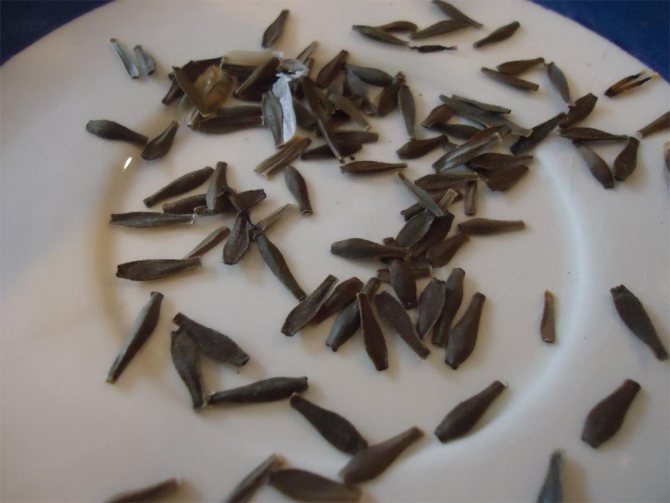

To obtain large bushes, it is better to choose tall varieties with double inflorescences. Among them, different forms are distinguished: radial, flat, spherical, bent, pompon, etc. They will bloom late, but will give out large flowers and powerful stems. This makes them suitable for cutting.
For flowerpots, rabatok, decorating loggias, it is better to stop at low-growing varieties, for example, "Figaro", "Mignon" or "Vasilisa". In these varieties, seedlings appear early, and the inflorescences have a long flowering period. In warm climates, these popular varieties can be sown directly into the soil when the weather is stable without fluctuations in temperature. For seed germination, the sowing beds are covered with foil.
Planting seeds in the ground
This process consists of the following steps:
- To obtain seedlings, any clean containers in which drainage is provided are suitable. Holes must be made in plastic containers.
- Pour sand-peat-perlite soil into the container. Simple soil is not suitable for obtaining seedlings: having the property of being strongly compacted, it will have a bad effect on the health of the sprouts. If it is not possible to acquire nutritious soil, peat, sand, organic fertilizers, taken in equal parts, should be added to the garden soil.
- On the eve of sowing, the seeds should be soaked in warm water. You can add a few drops of aloe juice to the water. It will make the plant stronger and healthier.
- Sow seeds in prepared containers with soil in a hole 1.5 cm deep, sprinkle with a handful of earth on top and sprinkle with water. Maintain the distance between the seeds 2 - 3 cm.
- Cover containers with plastic wrap and place in a warm place. This trick will create a greenhouse effect.
- When the shoots appear (after 15-20 days), the shelter must be removed. In the presence of 2-3 leaves, a pick is made into separate pots or cups with a soil mixture of sand, turf and peat (1: 2: 1). It is convenient to transplant seedlings with a teaspoon, since its oval edges cannot damage young roots, and the sprout will pick up along with a lump of earth. When picking, deepen the sprout into the soil to the lower leaves.
- When the sprouts are taken, they should be fed with complex fertilizer. The dosage is taken half as much as indicated in the instructions.
- Provide flowers with moderate watering and good lighting. Annual dahlias grow quickly. To prevent the plant from stretching too much, it should be pinned at the level of the 4th leaf.
- When warm weather comes, the seedlings need to be hardened. To do this, pots with seedlings are exposed to the air for a while, gradually increasing the hardening time. After 2 weeks, dahlias should be in the wind and sun for a full day. Tempering promotes healthy and strong seedlings, as well as quick and painless adaptation in the open field.
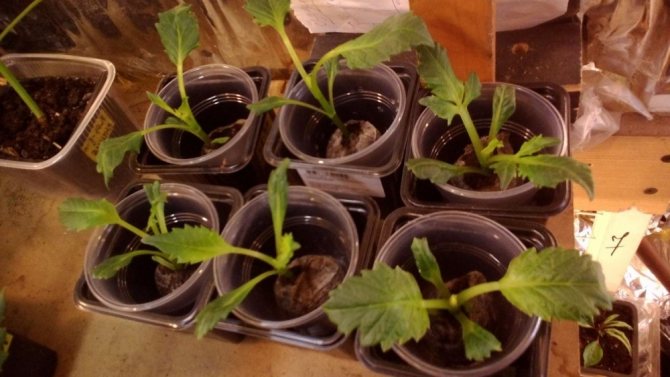

Advice. Some summer residents peat tablets are used for sowing seeds, for example, for pompom varieties. One tablet contains 2 seeds.
Planting seedlings in the ground
It is necessary to plant ready-made seedlings on the site when there is no threat of night frosts. To do this, pits about 40x40x40 cm in size are prepared on the flower bed, on the bottom of which a layer of humus is laid, on top - a layer of earth. Then the plant is carefully planted in the hole along with the lump, moistened and sprinkled with a layer of mulch. If the seedling was grown in a peat or paper container, then dahlias can be planted in the ground together with a pot, without disturbing the rhizome. The first 3-4 days, until the sprouts take root, it is better to cover them with foil or a jar.
The distance between seedlings should be maintained based on the planted annuals:
- for tall varieties - 70 cm;
- medium-sized - 50 cm;
- for dwarfs - 30 cm.
Feeding young dahlias should be done only after the plant takes root, as the stem and leaves get stronger.
On the agricultural technology of culture
The agrotechnology of plant breeding is quite simple and even a novice florist can do it:
- Soil requirements. It is not recommended to choose places for planting flowers located in swampy and damp areas where root tubers can rot. A flower crop will not bloom well in the shade of large trees, as they dry out and draw moisture and nutrients from the soil. It is advisable to plant perennial dahlias in areas with well-fertilized and cultivated soil. The increased demands on the quality of the soil is explained by the intensive formation of the root tubers of the plant from the beginning of planting in the ground. Such active growth is associated with the absorption of large amounts of the elements nitrogen, potassium and phosphorus from the soil. Perennial dahlias take root on any type of soil. Oii grow equally well on black soil, loam, sandy soil, so they can be used to decorate any area.
- Illumination. Perennials delight with their lush flowering if they are planted in places sufficiently illuminated by the sun's rays, well protected from cold drafts. Although, due to the lack of free space in sunny places of a summer cottage or a front garden, plants have to be grown in shaded places. Different illumination affects the size of the flower and the brightness of the color. It has been noticed that dahlias grown in partial shade have a significantly longer flowering period.
- Humidity. For the lush flowering of dahlia flower crops, it is necessary to create a moderate humidity regime. Timely and abundant watering creates the necessary conditions for the formation of beautiful and large inflorescences. In hot weather, moisture from the soil evaporates quickly, so the soil is mulched with peat or dry grass. Dahlias are best watered in the evening, after the summer heat has subsided. The plants are also very responsive to the "summer shower", such spraying can be carried out several times a day.
Remember! The successful cultivation of perennial dahlias largely depends on compliance with the rules of crop rotation, which do not recommend planting plants in one place in a row for more than two years.This requirement is associated with the accumulation of diseases and pest infestation of the root tubers of the flower culture.
On a note. Perennial dahlia differs from annuals in that the root tubers of the plant must be dug up for the winter and carefully stored until spring.
How to store dahlias in winter
After the dividing procedure, you need to check each part of the tuber for brown or red spots. If you find any, you need to immediately get rid of the sick specimen.
The remaining tubers are washed and treated with a fungicide for disinfection. Tubers are dried on a sheet of paper. At this time, you need to mark the varieties with the help of tags.
The tubers are stored at a temperature not lower than +1, but not higher than +5. The basement is ideal for such purposes. Tubers are pre-placed in bags with sawdust. If the indoor humidity is low, then sand can be used.
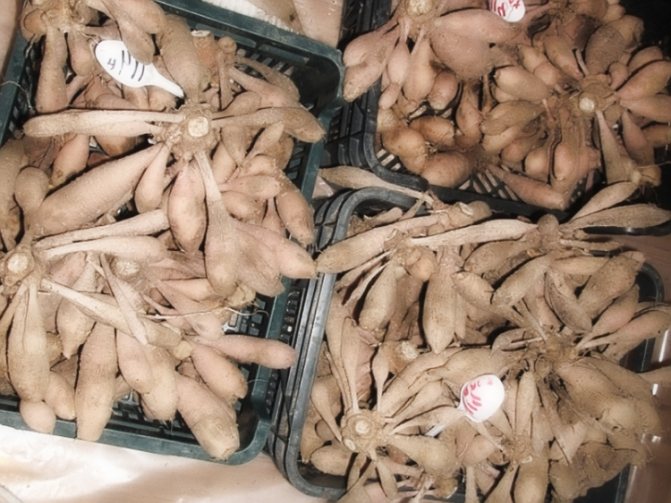

Choosing a landing site
Dahlias are thermophilic. To achieve a beautiful, abundant flowering, you need to choose the right place for planting. Consider the biological characteristics of the culture:
- short growing season;
- intolerance to drying out of the soil;
- the need for regular watering;
- fragility of hollow stems.
Choose a sunny, well-ventilated area for your dahlia. A prerequisite is the absence of a draft. They feel great under the protection of buildings, tall shrubs, subject to good illumination, warming up the soil. A light partial shade of a garden or park is suitable.
Signs of lack of sunlight:
- looseness of the bush;
- thin stems;
- elongated peduncles;
- poor flowering;
- discrepancy between the size of the inflorescence and the specific diameter.
Areas with a high groundwater table are equipped with a drainage system. Conversely, in the southern arid regions, the flower beds are slightly deepened for abundant watering.
Taking into account the natural conditions of the region, they choose slopes protected from cold winds or hot dry winds. Areas with lowered terrain, where cold air accumulates, are unfavorable, there are late frosts.
Description of annual dahlias
One of the main features of annual flowers is their compactness.
The plant is very thermophilic, it does not tolerate frost.
Annual dahlias - grown from seeds:
Flowers are very diverse in shape:
- Cactus;
- Pompom;
- Simple;
- Semi-double;
- Collar.
Dahlias are bred in three ways:
- Planting seeds;
- Dividing the tubers;
- Cuttings.
REFERENCE: For growing in houses and apartments, flower growers have bred special dwarf varieties of dahlias.
Annual flowers are grown in unprotected ground, greenhouses and flower pots.
The growth of annual plants does not exceed 50-50 cm. After the formation of buds, dahlias bloom long and beautifully.
Annual dahlias get along well with other garden plants and flowers. Caring for one-year-olds is simple - they do not need to be tied up, pinched and pinched like perennial dahlias.
How to plant dahlias outdoors in spring
Dahlias are characterized as unpretentious ornamental plants and are easy to grow in the garden at home. But despite this, you should choose a suitable place on the site. To enjoy the results of labor, it is advised to properly prepare the tubers. The soil is fertilized with nutrients necessary for the full growth and development of the plant. It is important to take into account the distance between seedlings when planting in open ground.
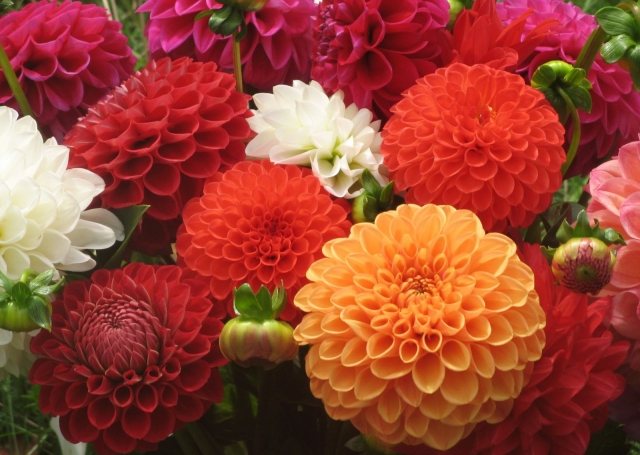

Dahlias have leaves arranged in pairs on the stem. The height of the decorative culture reaches up to 2.5 meters. The plant has a well-developed root system. In perennial varieties, tubers are fleshy and thickened. Stems are smooth or rough. The flowers are highly branched. There are known varieties with feathery and drooping leaves. Dahlias are distinguished by the presence of inflorescences-baskets. There are species with brown-red or golden-yellow central reed-type flowers.The aerial part of the plant dies off to the root collar.
The main thing in the planting process is the preparation of the tubers. Every autumn they are dug up and stored in the underground or in the cellar. But before that, they should be dried so that they do not rot during the winter.
If some of the parts of the tubers are rotten, they are removed, the onions are cleaned from shriveled lumps of earth. Those that are damaged should be thrown away so as not to endanger others. The damaged parts are separated with a knife. The cut site is treated with a weak solution of potassium permanganate or sprinkled with charcoal, grinded into powder. The node is divided into parts. Each part consists of two sprouted tubers. This is done in order to get a plant with a large supply of vitality, giving a lot of buds. The increase in tubers will lead to shredding of the shoots, which will subsequently interfere with the growth, which will affect the quality of the inflorescences.
Correct planting of a dahlia
To begin with, prepare dahlias for seedlings. Early and medium varieties are planted in mid-March. Specific timeframes are disclosed in detail gardener's lunar calendar. In 2019, the following days are a good time for planting:
- for annual dahlias: March 4-8, March 13-15, March 18-26, March 28-30;
- for perennials: March 4-8, March 10-13, March 22-24, March 28-30 .;
Experts do not recommend planting seedlings on March 2, 3, 16 and 17.
The container is filled with balanced soil. It can be prepared at home, you can buy ready-made soil. It is better to buy ready-made, since such planting material contains all the nutrients and useful trace elements.
The soil at home should be decontaminated. There are several methods. To destroy harmful bacteria, the soil should be frozen or calcined in the oven at 150-180 degrees. Also, in a skillet, the soil is fried over an open fire. Then the planting material is left for two weeks at room temperature in order to restore useful trace elements. The ground should be soft, loose. Planting seedlings has its advantages. You can count on early flowering, while when planting seeds directly into the ground, the flowering period occurs later. After planting a plant in a pot, leave it until it adapts and sprouts. The containers are placed on a windowsill or in a greenhouse.
You can plant dahlias in the spring immediately in open ground, but only after the frost has receded. This applies to medium and late varieties. If planted earlier, the tubers may freeze. The planted bulbs can be covered with any warm material, straw or hay in case of unexpected cold weather.
As soon as the weather is warm, that is, the temperature begins to be kept within the range of 10-15 degrees Celsius, then it is time to disembark in the open ground.
They dig up the soil and add compost or rotted manure to it. The soil is loosened with a pitchfork, and bone meal is introduced into it. To protect flowers from wireworm and onion root mite, granular insecticides are added to the soil: a solution of copper sulfate, potassium permanganate. Formalin can be used if roses or fruit crops that have undergone any diseases were grown in this place before dahlias.
For transplanting seedlings or for planting dahlias with tubers, small holes are dug into the ground at a distance of a meter and a half from each other. The distance is chosen depending on the expected growth of the plant. For short ones, 40-50 centimeters are suitable. The hole depth should be no more than 10 centimeters. It is not worth deepening too much. Watered dry land with water before planting seedlings. The tubers are laid horizontally so that the dahlia can develop a large root system. When planting, the roots are completely immersed in the holes. A place for fertilizing is left in the hole.A little rotted manure is put on the bottom, but you should be careful not to burn the roots. The hole is filled up, leaving shoots a few centimeters above the ground. If the seedlings are tall, then a support is installed when planting, it can be left stuck into the hole, since after a month or two it will not be possible to install the support without damaging the rhizomes of the flower. The bulky bush is supported with several sticks.
Gardeners of the Middle Lane, as well as in the Urals and in the Moscow Region, plant dahlias in the Leningrad Region in May. In Siberia, this period may fall in June. In the southern regions, work is shifted a month earlier, that is, to April.












